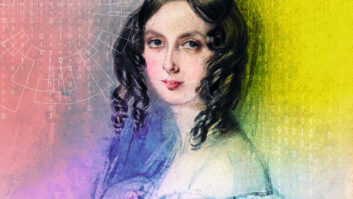
Visitors to BVE this year will no doubt have had the opportunity to see the latest camera releases, improved audio tools, product updates, an the new launches of countless other pieces of gadgetry. Yet at the heart of BVE, of broadcast, and of this wealth of technology is something less tangible: storytelling. This subject was the focus of a keynote session on the last day of the show, presented by Kati Price, head of digital media at London’s Victoria and Albert museum.
An anthropologist, Price’s career change to digital communications in 2013 didn’t involve the dramatic shift one may expect: “today’s digital media and social media are not that different from cave paintings”, she opened, “what we have is people trying to tell stories and communicate culture”. She provided a brief history of communication culture, starting with cave paintings and Egyptian tablet and stylus (terms which have come full circle today), moving on to the first Edwardian camera, cinema, and the invention of the television. Today we are using a massive variety of media to communicate and engage, but the purpose of these different channels, said Price, is the same as cave paintings and papyrus, there are just more of them.
We may have the same desire to communicate as civilisations before us, but a point – or a fear – which is raised repeatedly is that we spend too much time on communication devices rather than communicating in person. People fixated on their phone or tablet is a typical sight on a daily commute, but is also increasingly common among members of the same family, in the same house, consuming their own content on their own devices. Price was quick to play this down, asserting that this ‘problem’ has long existed, showing an illustration from 1906 of a couple ‘not communicating with each other’ and instead using wireless telegraphy. The fear then, and now, is that “technology is separating these two people and not empowering them”.
Technology, though, is merely a way of transmitting stories and “what people want, ultimately, is stories”, said Price. Stories are our way of transmitting culture, of sharing ideas and emotions and something Price as an anthropologist said we are “hardwired to understand and appreciate”. With the proliferation of physical pieces of technology on show at BVE then, where do objects come into this storytelling? Price demonstrated the literal value of storytelling by using the example – and telling her audience the story – of a buggy which sold on eBay for over £150,000. This was a result of the seller attaching a personal anecdote to the advert, which cited the buggy as signifying “everything that ended my happy carefree low cost child free life.” It is stories that bring objects to life and give them value, but Price takes this one step further, and asked, “what if objects themselves could tell stories?”
This is an interesting question when considering the potential of the internet of things, a network of physical objects and smart devices which enables extensive connectivity and communication. “In the internet of things”, said Price, “objects may start determining their own futures”. The idea of objects telling stories has been explored in projects including Hello Lamppost, a 2013 project in Bristol and city-wide ‘platform for play’ which allowed participants to ‘communicate’ with street furniture via text, with prompts and questions. “The possibilities that digital enables are really interesting”, but how does this translate to a museum setting? With over a million objects at the V&A how are these possibilities being seized to communicate and tell stories?
Objects remain at heart of the museum’s digital initiatives: “Physical objects – nothing beats them” Price said. But, “we’re exploring how to do what digital does best, and what can’t be done by the physical”. This includes London Recruits, an experiential documentary to accompany Disobedient Objects, a recent exhibition which examined the role of objects in movements for social change. The Strawberry Thief game was another digital development at the museum, which allowed users to interact with and learn about a William Morris pattern of the same name, which received 50,000 downloads in its first week, Price reported.
Digital technology helps bring people closer to, and educate them on, physical objects and their stories, but this will also help bring people closer to people. The V&A’s upcoming Alexander McQueen exhibition, Savage Beauty, will showcase the late designer’s body of work, allowing visitors to the museum to see items from his 1992 MA graduate collection to his unfinished A/W 2010 collection. However, it is the digital element which will add an extra dimension, allowing visitors to get “up close and personal” with objects in the exhibition including sharing McQueen’s designs via social media.
Digital initiatives such as these are not intended to replace the physical experience of visiting the exhibition and understanding the stories behind the objects on show – “don’t try to replace or replicate physical experiences”, Price warned – but to augment them. She concluded that we should remember the value of stories (think of the extortionate cost of the buggy after it was partnered with a story); we should think about objects as the new storytellers themselves; and “use digital to do what digital does best”. This is, in the end, is the continuation of storytelling which began which our forebears and which will continue to generate “citizenship and interaction between people” into the future.







